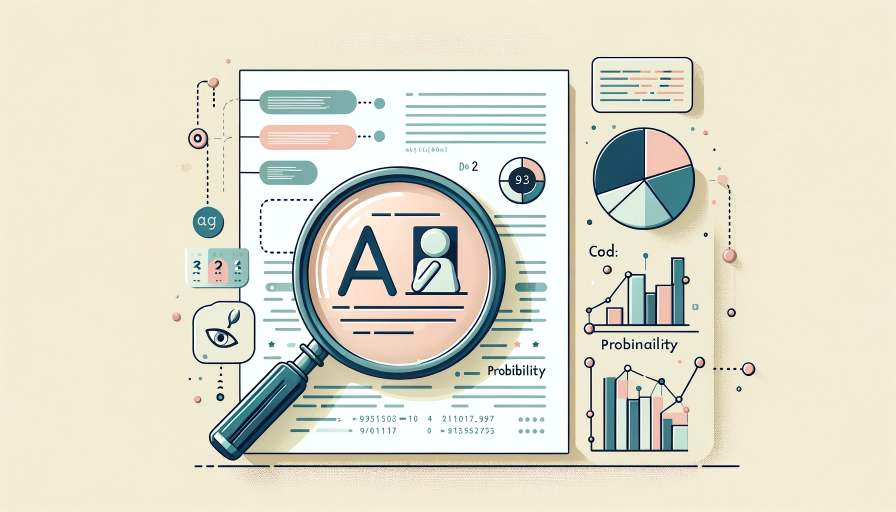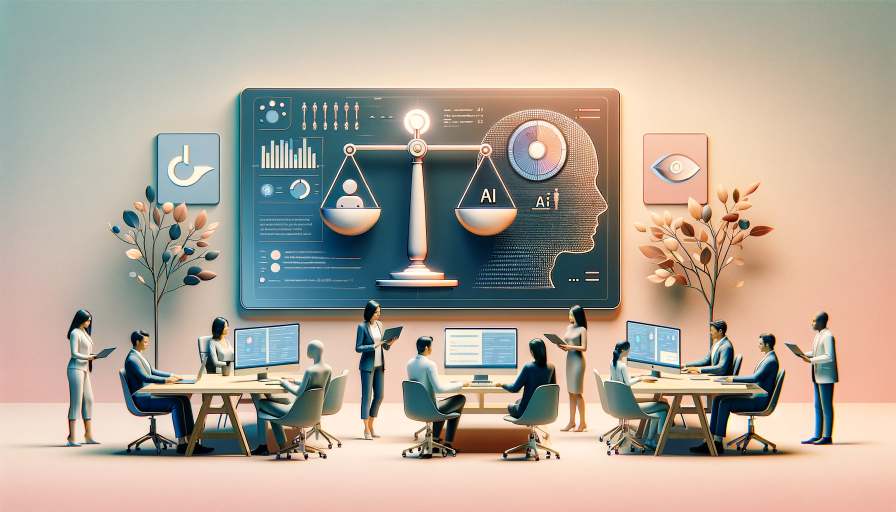As AI-generated content becomes increasingly prevalent in various domains such as academia and content marketing, it’s essential to understand what percentage of AI detection is allowed in writing. There is no universally accepted percentage for AI content, as standards vary based on individual or organizational requirements. Aiding in this regard, AI detection tools like Originality.AI, Turnitin, and Copyleaks offer nuanced approaches to detecting AI-generated content, allowing decision-makers to assess the acceptability of mixing AI or human-produced work. These writing tools not only provide benchmark metrics for maintaining academic integrity but also influence content marketing strategies in a constantly evolving technological landscape.
Deciphering AI Scores in Content Creation
Understanding AI scores in content creation entails interpreting the probability metrics provided by AI content detection tools like Originality.AI. These metrics express the likelihood of content being AI-generated or human-generated, rather than pinpointing the exact portion of AI-generated text. For instance, according to Originality.AI, a score indicating 95% human and 5% AI means there’s a 95% chance the content is human-generated.
Though these AI detectors are known for their high accuracy, perfect detection is not guaranteed. Consequently, it is recommended to review a series of results from the same source for a more reliable assessment. Originality.AI’s AI detection is designed to inform users and align with content marketing strategies while ensuring transparency throughout the content creation process.
According to Originality.AI, a score indicating 95% human and 5% AI means there’s a 95% chance that the content is human-generated.
In order to better interpret results from these AI detectors, it is essential to familiarize oneself with the AI detection capabilities of the tool being used. Here are a few useful terms and their meanings:
- Generative AI: AI algorithms that generate new content based on training data.
- AI writing detection feature: A feature in AI detectors that identifies AI-generated content.
- Probability metrics: Measurements used to convey the likelihood of content being AI-generated or human-generated.
Furthermore, understanding the diverse types of AI writing tools and the levels of their AI detection capabilities can assist users in making informed decisions on which tools are most appropriate for their needs:
| AI Detector | AI Detection Capability |
|---|---|
| Originality.AI | 94% accuracy for detecting GPT-3 |
| Turnitin | Flags 3.3% of student papers as containing 80% or more AI-written text |
| Copyleaks AI Content Detector | 99.1% accuracy and 0.2% false positive rate for human-written content |
In conclusion, deciphering AI scores is vital in determining the level of AI-generated content within written text. By understanding the probability metrics and the capabilities of AI detectors, users can more effectively interpret results and maintain academic integrity or adhere to content marketing guidelines. As AI continues to evolve and its presence in writing expands, it is essential for writers, educators, and content creators to stay up-to-date with the latest AI detection tools and maintain transparency in the content creation process.

Guidelines and Thresholds for AI Content Usage
Different strategies for implementing AI writing assistance result in varying thresholds for AI content usage. According to Originality.AI, the recommended strategy can range from ‘No AI Ever!’ with a human average of 90%+ and a minimum of 65% to ‘Ethical AI Content’ where no specific human contribution target is set, implying acceptance of fully AI-generated content as long as it undergoes human editorial fact-checking.
Strategies for Implementing AI Writing Assistance
Organizations can adopt various strategies depending on their goals and comfort level with AI-generated content. Some strategies include:
- Manual editing of AI-generated content to ensure originality and authenticity
- Blending human-generated content with AI-generated content
- Using AI for research and fact-checking purposes
- Relying on AI solely for initial drafts and refining with human input
Setting Standards for Human vs. AI Generated Content
Setting standards for differentiating human-created content from AI-generated material is essential to maintaining academic integrity and preventing misconduct. For instance, Turnitin flags papers with significant AI text portions while encouraging discussions about appropriate use within an educational context. Originality.AI further helps users to understand and apply AI detection results to set intelligent, risk-based decisions on the threshold of AI content acceptable for publishing.
Impact of AI Detection on Content Marketing Strategy
The impact of AI detection tools on content marketing has led to the adoption of different strategies by publishers based on the level of AI involvement they are comfortable with. Originality.AI suggests various content strategies such as:
| Content Strategy | Average Human Score | Description |
|---|---|---|
| AI Used for Research | High | AI tools are utilized for research and data gathering, but human authors create the content. |
| Collaborative AI | Moderate | AI generates content that is edited and refined by human authors, ensuring a balanced approach to content creation. |
| Heavily Edited AI | Low | AI generates the initial draft, which is extensively revised by human editors before being published. |
| Ethical AI Content | Variable | No specific human contribution target is set, but AI-generated content undergoes human editorial fact-checking to maintain quality and accuracy. |
These strategies help publishers to align their content with the potential AI detection by marketing strategies and tools like Google’s algorithms, ensuring that their content marketing efforts remain effective and compliant with ethical guidelines.

Distinguishing Between AI-Generated and Human-Created Text
Being able to effectively distinguish AI-generated from human-created text is crucial in various domains such as academic integrity, content creation, and plagiarism detection. This involves analyzing the specific signatures and patterns indicative of AI-generated content and human-created content. Numerous generative AI tools and detection systems have been developed to address this issue, providing users with valuable insights into the nature of the content under scrutiny.
“The distinction between AI-generated and human-created text is increasingly important as AI technology evolves and its use becomes more widespread.”
One such detector is the Copyleaks AI Content Detector, which utilizes specialized techniques to recognize AI-generated content. With a reported accuracy of 99.1% for English text, this detector highlights the specific parts of the text that are AI-written, providing users with an in-depth understanding of their content’s composition.
Similarly, Turnitin acknowledges that a high proportion of AI-dependent statistical signatures does not necessarily equate to misconduct, particularly when AI is allowed for classroom use. As a result, Turnitin emphasizes the importance of interpreting AI-generated content within the context of its intended use.
Meanwhile, Originality.AI is developing a highlighting solution to identify blocks of text likely generated by AI. This additional feature aims to provide further clarity in the distinguishing process, allowing users to make informed decisions about their content.
Several factors aid in distinguishing between AI-generated and human-written content:
- AI-generated content tends to exhibit repetitive patterns and phrases.
- AI-generated text may lack a coherent narrative or logical flow.
- Human-created content often contains unique stylistic elements and phrasing.
| Detector | AI-Generated Content Detection Technique | English Text Accuracy |
|---|---|---|
| Copyleaks AI Content Detector | Utilizes specialized techniques to recognize AI-generated content. Highlights specific parts of the text that are AI-written. | 99.1% |
| Turnitin | Focuses on AI-dependent statistical signatures. Encourages users to interpret AI-generated content within context of its intended use. | Unavailable |
| Originality.AI | Developing a highlighting solution to identify blocks of text likely generated by AI. Provides insights and supports informed decision-making. | Unavailable |
As AI technology continues to advance, distinguishing between AI-generated and human-created text remains a crucial aspect of content management, academic integrity, and plagiarism detection. The appropriate use of AI-generated content will still be contingent on the context in which it is used, and the evolving standards that govern the integration of AI tools into various domains.
Conclusion
In conclusion, the acceptability of AI-generated content depends on various factors, such as the interpretation of nuanced AI scores provided by detection tools like Originality.AI, Turnitin, and Copyleaks, as well as the institution’s policies and the intended use of the content. All these aspects play a crucial role in determining what level of AI assistance is deemed acceptable within the realms of academic integrity and content marketing.
These AI detection tools offer high accuracy in assessing the original content and AI-generated portions, forming a solid foundation for discussions and guidelines surrounding the ethical use of AI writing tools. Furthermore, they provide valuable insights into the interpretation of AI scores and aid in establishing appropriate thresholds for AI content usage across various domains.
As the influence of AI continues to grow, it is essential for educators, publishers, and content creators to stay ahead of the curve by adapting their standards and guidelines for AI content creation and detection. Embracing a well-informed and responsible approach towards AI integration is paramount to ensuring the quality, authenticity, and value of content produced, while safeguarding the principles of academic integrity and ethical content creation.
FAQ
What percentage of AI detection is allowed in writing?
There is no universal percentage for allowable AI-generated content, as it depends on an individual or organization’s preferences and standards. Some AI detection tools, like Originality.AI, offer a nuanced approach to determine human vs. AI scores, while Turnitin assesses the prevalence of AI in student papers to uphold academic integrity. The acceptable percentage lies in understanding the intended use of content and the principles set by the institution or content creator.
How are AI scores deciphered in content creation?
Deciphering AI scores means understanding the probability metrics provided by detection tools like Originality.AI, giving users an idea of the likelihood that content is AI-generated. These tools have high accuracy, but perfect detection is not guaranteed. It is recommended to review series of results from the same source for a more reliable assessment to ensure responsible use of AI in content creation.
What are the guidelines and thresholds for AI content usage?
Implementing AI writing assistance involves varying thresholds and strategies depending on the level of AI involvement that users are comfortable with. Recommended content strategies range from ‘No AI Ever!’ with a human average of 90%+ and a minimum of 65% to ‘Ethical AI Content’ with no human contribution target as long as human editorial fact-checking is conducted. Establishing standards for human vs. AI-generated content is vital for maintaining academic integrity and preventing misconduct.
How is the impact of AI detection on content marketing strategies managed?
The adoption of AI content detection influences organizations’ content marketing strategies, which vary depending on their level of comfort with AI involvement. Originality.AI suggests strategies like ‘AI Used for Research’ or ‘Heavily Edited AI’ where human scores vary to align with potential AI detection by marketing tools and algorithms. These strategies ensure that AI integration within content marketing maintains high-quality and ethical content.
How can AI-generated and human-created text be distinguished?
Distinguishing between AI-generated and human-created text involves utilizing detection tools such as Copyleaks AI Content Detector and Turnitin, which analyze content and recognize AI-generated text with high accuracy. These tools identify signatures and patterns indicative of AI-generated content and clarify the source of writing. Originality.AI is also developing a highlighting solution to identify blocks of text likely generated by AI, offering even greater clarity in the distinguishing process.
If you like this post check out other AI-related articles:


